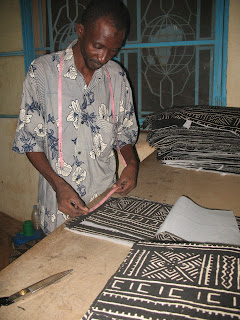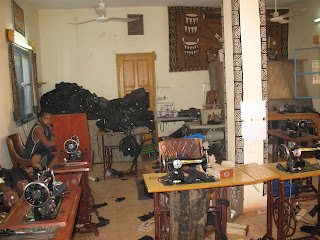 An example of the amazing beads that Baba has in his museum.
An example of the amazing beads that Baba has in his museum.
Shameless plug, but check out http://www.farafinatigne.com/ to see what he does. He had a successful business and did some work with bogolan – or mud cloth - which is a cloth here that we dye using mud and is used for all sorts of purposes (to reintroduce you to my blog on the making of bogolan, check out A Day in the Life of Bogolan from June). Hallmark decided that they wanted to make some handbags for their stores. We met with tailors and chose a core team to work with for our additional order bags. We set up schedules and workshops and an assembly line – things that had never been done here before. We taught tailors the importance of using a tape measure to get accurate measurements, instead of just eyeing it, which is what they commonly do here.
We went through every stage of production and quality control and shipping. Production started around June 18th, and we’ve been producing almost every day and shipping every week since then. Production starts with measuring and cutting the bogolan into preset dimensions. We made models that could be traced in order to make sure each piece was exactly the same. After all of the pieces are cut, they’re brought down to the workshop, or in French atelier, and the assembly line begins. Here are some photos of the production:
 Measuring and cutting the body of the bags.
Measuring and cutting the body of the bags.
 Hundreds of bodies and bottoms cut out, ready to head down to the workshop to be sewn.
Hundreds of bodies and bottoms cut out, ready to head down to the workshop to be sewn.
 Day 1 of production. People were fresh eyed and the workshop was still clean!
Day 1 of production. People were fresh eyed and the workshop was still clean!
 Attaching the popline, or black lining, to the bottom of the bag.
Attaching the popline, or black lining, to the bottom of the bag.
 We set up an additional workshop in Mopti and didn't put motors on the machines. He was making the bags with his feet (foot pedal), literally.
We set up an additional workshop in Mopti and didn't put motors on the machines. He was making the bags with his feet (foot pedal), literally.
 The day that Hallmark came to shoot, everyone got dressed up in traditional clothes.
The day that Hallmark came to shoot, everyone got dressed up in traditional clothes.
 A bag in progress. He sewed the Hallmark labels on the inside of the bags.
A bag in progress. He sewed the Hallmark labels on the inside of the bags.
 Hard at work lining the bodies of the bags.
Hard at work lining the bodies of the bags.
 It's always nice to see a huge pile of bags done and waiting to be controlled!
It's always nice to see a huge pile of bags done and waiting to be controlled!
 Cutting the handles for the bags and attaching them.
Cutting the handles for the bags and attaching them.
 This is how the workshop normally looked - cluttered and messy with random bags and pieces of bogolan around.
This is how the workshop normally looked - cluttered and messy with random bags and pieces of bogolan around.
At the end of every shift, bags are piled – and I do mean piled – into a storeroom to await finishing touches such as labels and then they’re sent off to Quality Control.
 Hundreds of bags piled awaiting finishing touches and to be controlled.
Hundreds of bags piled awaiting finishing touches and to be controlled.
Quality Control was probably one of the most frustrating parts of this project. Things here aren’t QC’ed. Tailors will make your clothes and give them to you and if there’s a problem you can bring them back. They don’t cut off loose threads, they don’t verify measurements – they just don’t! So, the education aspect of all of this, trying to teach people that we needed 20,000 identical handmade bags was hard even for me to imagine. In the end, in all worked out and we were able to successfully QC most of our bags.
 Our Quality Control team working on verifying measurements, cutting off excess strings and making sure the bags were ready for shipment to the States.
Our Quality Control team working on verifying measurements, cutting off excess strings and making sure the bags were ready for shipment to the States.
 Quality Controlling continues.
Quality Controlling continues.
 At the end of every day, we count the bags into stacks of 20 for packaging. The RED labels amongst the sea of black and white is pretty awesome.
At the end of every day, we count the bags into stacks of 20 for packaging. The RED labels amongst the sea of black and white is pretty awesome.
 The bags are then bundled up into big fabric or plastic sacs to send down to Bamako.
The bags are then bundled up into big fabric or plastic sacs to send down to Bamako.
There was even one night we took all of our finished bags to Peace Corps Baba’s house in Mopti and I worked with his wife and some other women until 2:30 AM to control them. Most Malians don’t work like this, but Baba is almost American, so I can’t expect anything different!
 Peace Corps Baba's wife and family friends working late into the night controlling bags.
Peace Corps Baba's wife and family friends working late into the night controlling bags.
After we QC everything, we pack it up. We have to ship everything down on public transport, so it’s important that the packages aren’t too big. We normally put between 300-500 in each package and take them to our friends at Bani Transport to haul all the way down to Bamako.
 Our good friends at Bani Transport were always really excited to see us every week and try to get more money out of us for shipping these packages. On average, we paid $4-$6 per package to go to Bamako.
Our good friends at Bani Transport were always really excited to see us every week and try to get more money out of us for shipping these packages. On average, we paid $4-$6 per package to go to Bamako.
Once in Bamako we do another QC check, but also sort and count everything and add a silica gel pack (to absorb any moisture). Our team in Bamako packages all of the bags in cardboard boxes and we haul it all off to fumigation. Of course, during the process of QC –both in Sevaré and in Bamako we find bags that have problems. Maybe it’s a hole where the sewing machine didn’t catch the fabric, a missing label or a measurement gone terribly wrong. Either way, we have to deal with all of these things and it takes time.
 The team in Bamako. Here they do one final QC check and add silica gel packs to each bag.
The team in Bamako. Here they do one final QC check and add silica gel packs to each bag.
 It's tiring, especially during Ramadan, so breaks are often taken. The bags provide a comfortable resting place, not just a trendy handbag!
It's tiring, especially during Ramadan, so breaks are often taken. The bags provide a comfortable resting place, not just a trendy handbag!
 After all of the silica gels have been added, packaging for fumigation begins. We put 150 bags in each box.
After all of the silica gels have been added, packaging for fumigation begins. We put 150 bags in each box.
 Good thing we did that 2nd QC check - these are all of the bags that we found fault with.
Good thing we did that 2nd QC check - these are all of the bags that we found fault with.
 Just an example of the fault - this piece of bogolan for the body was not well cut.
Just an example of the fault - this piece of bogolan for the body was not well cut.
After a day or more in fumigation, all of the boxes head to the airport to fly out, via DHL. I haven’t spent enough time on the Bamako side to photograph the latter two things, but you get the idea.
So, there you have it. The birth of a bogolan bag produced especially for Hallmark’s Product Red line. Oh, I didn’t mention that, did I? Yeah, these bags are a part of Bono’s Product Red line in which a certain percentage of profits goes to the Global Fund to help fight AIDS in Africa. Talk about the perfect project – bogolan bags produced in Mali with local goods and the profits from sales come back to help them.
 Hallmark RED label on the inside of each bag. It reads: "This authenic mudcloth bag was made by artistans in the Republic of Mali in West Africa using traditional Bambara patterns. Natural earth dyes are used to make this 'bogolan' - or mudcloth - bag. Dyes may rub off on light colors. Hallmark is a proud partner of (Product)RED.
Hallmark RED label on the inside of each bag. It reads: "This authenic mudcloth bag was made by artistans in the Republic of Mali in West Africa using traditional Bambara patterns. Natural earth dyes are used to make this 'bogolan' - or mudcloth - bag. Dyes may rub off on light colors. Hallmark is a proud partner of (Product)RED.
 Here are the (RED) labels on the outside of each bag.
Here are the (RED) labels on the outside of each bag.
